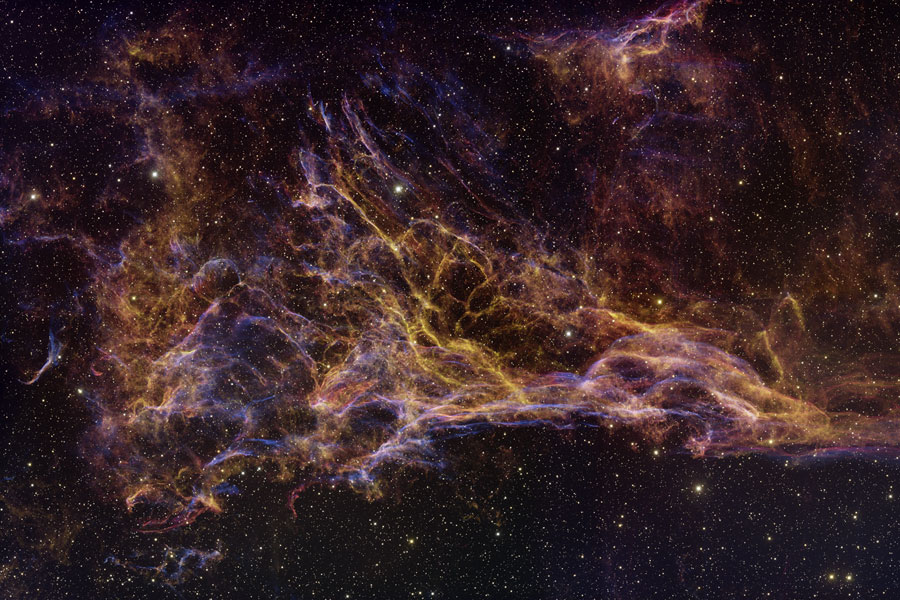2008. 7. 8. 09:28ㆍ3. 천문뉴스/NASA 오늘의 천체사진
이 사진에 보이는 것은 우리 은하에 속한 별의 잔해이다.
이 별은 약 7천 500년 전에 초신성 폭발을 일으켰는데 그 잔해는 현재 베일 성운이라 불리며, 백조자리고리(시그너스 루프)라고 불리기도 한다.
당시 폭발로 팽창하는 구름들이 초승달처럼 빛났으며, 그 잔해는 역사시대의 여명기를 살았던 사람들에게 관측되기도 했다.(참고 : http://news.bbc.co.uk/2/hi/science/nature/334517.stm)
오늘날 이 초신성의 잔해는 점점 희미해지고 있지만 백조자리 방향을 관측하면 작은 망원경이라 해도 관측이 가능한 상태이다.
비록 이 성운은 지구로부터 1400광년 떨어져 있지만 그 규모가 대단히 크기때문에 보름달 크기의 다섯배 정도 크기의 지역에 걸쳐 나타나고 있다.
열성적인 독자라면 사진에 나타난 성운의 모양과 유명한 천문학자의 이름을 따서 명명된 '피커링의 삼각형'을 알아볼 수 있을 것이다.
이 사진은 미국 아리조나에 위치한 키트 피크 국립 천문대의 4미터 메이올 망원경으로 촬영한 사진을 이어붙인 이미지이다.
정보출처 : NASA - 오늘의 천체사진(2008년 7월 1일 자)
http://antwrp.gsfc.nasa.gov/apod/ap080701.html
참고 : 베일성운을 비롯한 각종 성운에 대한 포스팅은 하기 링크 INDEX를 통해 조회할 수 있습니다.
https://big-crunch.tistory.com/12346974
원문>
Pickering's Triangle from Kitt Peak
Credit & Copyright:
(
),
,
,
,
,
Explanation: Wisps like this are all that remain visible of a Milky Way star. About 7,500 years ago that star exploded in a supernova leaving the Veil Nebula, also known as the Cygnus Loop. At the time, the expanding cloud was likely as bright as a crescent Moon, remaining visible for weeks to people living at the dawn of recorded history. Today, the resulting supernova remnant has faded and is now visible only through a small telescope directed toward the constellation of Cygnus. The remaining Veil Nebula is physically huge, however, and even though it lies about 1,400 light-years distant, it covers over five times the size of the full Moon. In images of the complete Veil Nebula, studious readers should be able to identify the Pickering's Triangle component pictured above, a component named for a famous astronomer and the wisp's approximate shape. The above image is a mosaic from the 4-meter Mayall telescope at the Kitt Peak National Observatory located in Arizona, USA.
'3. 천문뉴스 > NASA 오늘의 천체사진' 카테고리의 다른 글
| 초신성 SN 1006의 폭발잔해 (0) | 2008.07.09 |
|---|---|
| 처녀자리 은하단의 중심부 (0) | 2008.07.08 |
| 남극의 하늘 (0) | 2008.07.07 |
| 피닉스 호의 착륙 사진 (0) | 2008.05.30 |
| 피닉스 호가 보내온 화성사진 (0) | 2008.05.30 |
